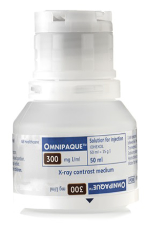
OMNIPAQUE 300mg I/ml Price
Active Substance: Iohexol.
Overview
Welcome to Dwaey, specifically on OMNIPAQUE 300mg I/ml page.
This medicine contains an important and useful components, as it consists of
Iohexolis available in the market in concentration
Name
Iohexol
Precaution
Asthma or a history of allergies (risk of anaphylactoid reactions is increased); compromised blood-brain barrier (severe neurotoxicity after intrathecal use); epilepsy and brain tumour (higher risk of convulsions); severe hepatic or renal impairment, diabetics with renal impairment, dehydration and others who may be at increased risk of renal failure; multiple myeloma (dehydration from use may cause precipitation of protein in the renal tubules, leading to anuria and fatal renal failure); severe hypertension; advanced cardiac disease; phaeochromocytoma; sickle-cell disease; hyperthyroidism; debilitated, severely ill, very old, or very young patients; occlusive vascular disease. Special care to ensure that 140 and 350 mg iodine/ml solutions are not given intrathecally. Adequate resuscitative facilities should be available when radiographic procedures are undertaken, and patients should be kept under observation for a suitable period after the procedure. Lactation: Not known; not recommended
Indication
Radiographic contrast medium for diagnostic procedures
Contra indication
Procedure-specific. Intrathecal: Myelography in significant local or systemic infection where bacteremia is likely; concurrent use with corticosteroids; repeat myelography in the event of technical failure (risk of overdosage). Hysterosalpingography: During menstrual period or when menstrual flow in imminent; presence of infection; pregnancy, 6 mth after termination of pregnancy or 30 days after conization or curettage.
Side Effect
Flushing or a sensation of heat; pain, extravasation, thrombophlebitis at the inj site; nausea, vomiting, headache, and dizziness; urticaria, pruritus, pallor, sweating, metallic taste, weakness, coughing, rhinitis, sneezing, lachrymation, visual disturbances; hypotension, tachycardia, bradycardia, transient ECG abnormalities, haemodynamic disturbances; dyspnoea, bronchospasm, angioedema, severe urticaria; convulsions, paraesthesia, paralysis; acute renal failure; thromboembolism, disseminated intravascular coagulation, thrombocytopenia; hyperthyroidism, thyroid storm thyrotoxicosis. Potentially Fatal: Profound hypotension, pulmonary oedema, respiratory arrest, ventricular fibrillation, circulatory failure, cardiac arrest, coma.
Pregnancy Category ID
2
Mode of Action
Allows for radiographic visualization through the opacification of vessels and anatomical structures in the path of flow of the contrast media.
Interaction
Information not available
Pregnancy Category Note
Information not available
Adult Dose
Child Dose
Renal Dose
Administration
